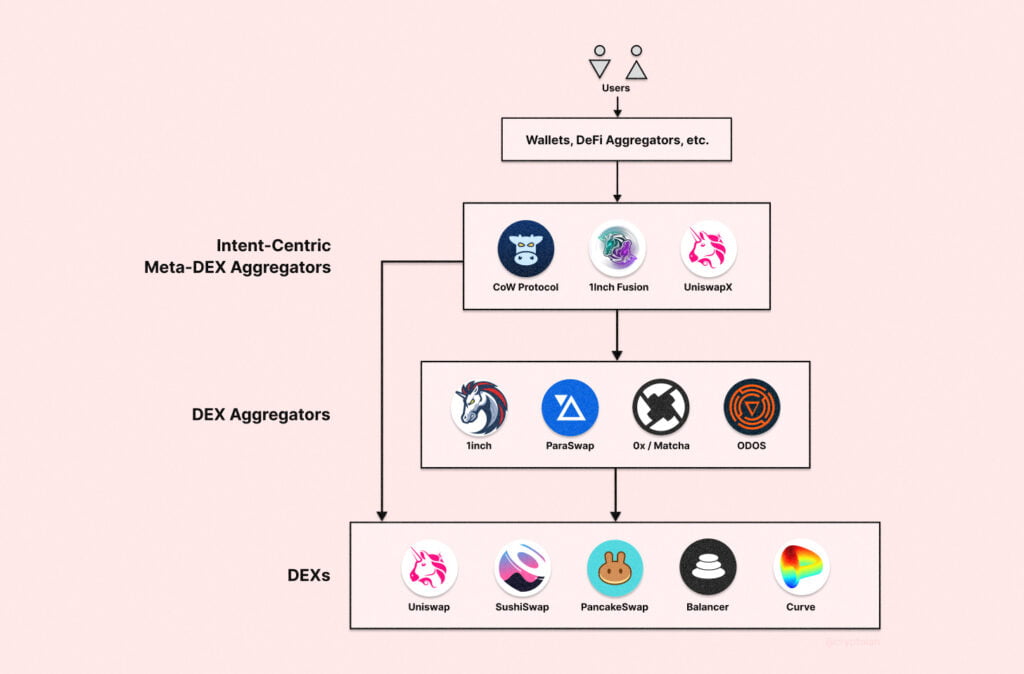Research Summary
The report discusses the concept of intents in the Web3 ecosystem, which are signed messages that simplify blockchain interactions by allowing users to express their on-chain goals. Solvers, who handle the technicalities, play a crucial role in optimizing transactions and incentivizing competition. The report also explores the limitations of Account Abstraction, the role of protocols like Anoma, SUAVE, and Essential in developing an intent layer, and the involvement of applications like UniswapX, CoW Swap, and 1inch Fusion in expanding functionality through solvers.
Key Takeaways
Understanding Intents and Solvers
- Role of Intents: Intents simplify Web3 interactions by allowing users to focus on their end goals without being bogged down by specific steps. They delegate complexities associated with blockchain interactions to solvers, improving the user experience in the Web3 space.
- Function of Solvers: Solvers act as intermediaries between user intents and blockchain execution, offering the most favorable execution prices. They compete on price and credibility to discover the best execution path and secure the best value for users.
- Impact on User Experience: Intents offer smoother transactions, faster execution, and improved user experience compared to the current transaction-based approach. They remove barriers for users by shifting from a transaction-based interaction to an intent-based approach.
Account Abstraction and its Limitations
- Role of Account Abstraction: Account Abstraction (AA) enhances Externally Owned Accounts (EOAs) by enabling their management through smart contract wallets or allowing smart contracts to directly initiate transactions. AA lowers entry barriers to personal wallets and provides users with more user-friendly account systems.
- Limitations of AA: AA is primarily engineered for single-domain usage and lacks the capability to operate seamlessly across multiple chains or support cross-chain paymasters. It still requires users to manually identify the most efficient route for order flows like swaps, bridging, or liquidity provisioning.
Intent-Centric Protocols and Applications
- General Purpose Intent Systems: Systems like Anoma and Flashbots’ SUAVE aim to introduce an intent layer where users can broadcast signed intents to gossip nodes. These systems bridge the gap between users who sign the intents and solvers who execute them across different networks.
- Intent-Specific Applications: Platforms like CoW Swap and UniswapX offer advanced intent-based solutions for limit orders in the market. Different protocols cater to specialized types of intents, such as swap-oriented intents and single-domain or wallet-centric intents.
Challenges and Opportunities in Intent-Centric Networks
- Fragmentation Issues: Platforms like CoW Swap and 1inch Fusion operate with distinct and non-intersecting intent pools, limiting aggregation and matching opportunities for solvers. Fragmentation hinders the propagation of network effects, which are important for the growth of intent-centric networks.
- Role of Anoma: Anoma serves as a unified intent-centric network, providing efficient and private means for counterparty discovery and multi-chain atomic settlements. Anoma’s gossip layer employs path authentication to improve efficiency and reward participation of solvers and gossip nodes.
- Future Potential: The concept of intents has the potential to improve the user experience in decentralized products and drive increased adoption. Innovations like SUAVE and Anoma are driving a paradigm shift by recognizing and realizing the user’s intent in swaps, staking, and other DeFi activities.
Actionable Insights
- Exploring the Potential of Intents: Intent-centric architectures emerge as a promising solution in Web3 interactions, aiming to enhance user experience and facilitate onboarding of new users. The integration of advanced AI has the potential to positively impact intent-centric setups by helping obscure complexities and bridging the gap in understanding user intent.
- Addressing Security Challenges: However, incorporating AI into the process may bring about security challenges, requiring the establishment of deterrents and penalties for malicious behavior and enhancing technical security.
- Recognizing the Role of Solver Networks: Solver networks and interplays with mechanisms like AA and bridging will play pivotal roles in realizing the practical applications of intents. The objective is to enhance the interoperable user experience, abstracting complexities between different blockchain ecosystems and empowering users to state their intentions while leaving execution to solvers.
- Investigating the Potential for Widespread Adoption: The widespread adoption of intents holds the potential to reshape how users engage with dApps and navigate the complexities of the Web3 ecosystem.











